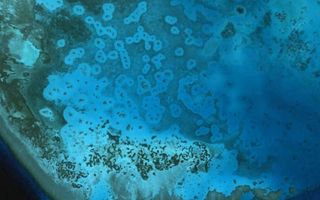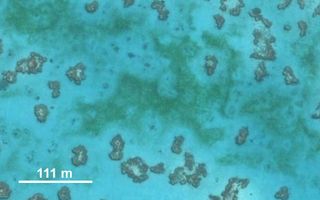Coral Reefs Have 'Halos,' and They Can Be Seen from the Heavens

What's the story behind mysterious "halos" of bare sand that surround coral reefs?
When reefs are healthy an unusual phenomenon occurs: a perimeter of bare sand forms around the corals. These so-called halos, or bright circles of sand that are devoid of vegetation are visible to satellites miles above Earth.
But until now, scientists didn’t fully understand exactly how they formed, and why some were bigger than others. Now, two new studies may help answer the mystery of how halos take shape and what conditions make them grow. [In Photos: Diving in a Twilight Coral Reef]
Mysterious halos
Halos occur when fish and invertebrate inhabitants eat algae and seagrass growing near the reef. Over time, all vegetation in this zone is cleared away; these empty stretches of sand can measure from hundreds of square feet to hundreds of thousands of square feet, and create a footprint around the reef that's visible from space.
Researchers in the two studies recently took a closer look at these halos. Not only did they observe reef animal activity that unexpectedly extended the perimeters of the halos, the researchers also determined that the halos could be used as barometers for reef health. Learning how to interpret halos from satellite images could help scientists monitor hard-to-access reefs, the study authors reported.
In one study, published online today (April 24) in the journal Frontiers in Ecology and Evolution, the scientists found complicated species interactions shaped halos in Australia's Great Barrier Reef.
Remote underwater video camera traps revealed that herbivorous fish weren't the only reef dwellers enlarging halos — fish that hunted burrowing invertebrates played a part as well. By digging in the sand for their prey, these carnivorous fish nudged sand-dwelling algae farther away from the reef and widened the halos' boundaries, the researchers reported.
Sign up for the Live Science daily newsletter now
Get the world’s most fascinating discoveries delivered straight to your inbox.
A pattern emerges
More clues about the halos emerged when the scientists examined high-resolution satellite images of coral reefs, publishing their findings today (April 24) in the journal Proceedings of the Royal Society B. They reviewed 1,372 reefs throughout the Great Barrier Reef, measuring features in 214 reefs; each of these contained hundreds to thousands of small, isolated coral platforms that were capable of being surrounded by a halo.
The study authors also conducted underwater surveys with camera traps at 22 halo locations, for three weeks.
The scientists were then able to directly compare halo patterns in waters where fishing was permitted — which would therefore have fewer predatory fish — and in waters that were protected, where predators would be plentiful.

The study authors suspected that in predator-rich protected waters, herbivorous fish would be more cautious and would graze close to the coral reef; the halos would therefore be smaller. In reefs that were open to fishing and had fewer predators, the scientists expected that grazing fish would be bolder, and that halos would reach farther from the reef, or would even be overgrown and disappear. But halos in both protected and unprotected waters turned out to be pretty much the same size, the study authors reported.
However, they discovered that halos were more likely to form in protected marine areas, "especially the older protected areas where predator populations have had longer to recover from previous fishing," lead study author Elizabeth Madin, an assistant research professor with the Hawaii Institute of Marine Biology at the University of Hawaii at Manoa, told Live Science.
That demonstrated to the researchers that halos could be a reliable indicator of stability in a reef's predator-prey populations, "which is an indicator of a healthy reef ecosystem," Madin said.
Their findings present new evidence showing how laws prohibiting fishing near reef communities can improve reef health, according to the study.
Coral reefs are typically monitored by divers that count species and evaluate the condition of corals and other life. However because halos are visible from space, satellite images could complement those surveys by providing snapshots of how reef halos change over time, Madin explained.
They also offer a glimpse at reefs that are inaccessible to divers, she added.
"We can look at them almost anywhere from satellite imagery, so this will give us a much broader view than what we could ever hope to do with the traditional monitoring methods. It would complement and scale what we can see," Madin said.
- Image Gallery: Great Barrier Reef Through Time
- Pretty in Pink: Photos of Bubblegum Coral
- Photos: The Secret Lives of Corals
Originally published on Live Science.

Mindy Weisberger is an editor at Scholastic and a former Live Science channel editor and senior writer. She has reported on general science, covering climate change, paleontology, biology, and space. Mindy studied film at Columbia University; prior to Live Science she produced, wrote and directed media for the American Museum of Natural History in New York City. Her videos about dinosaurs, astrophysics, biodiversity and evolution appear in museums and science centers worldwide, earning awards such as the CINE Golden Eagle and the Communicator Award of Excellence. Her writing has also appeared in Scientific American, The Washington Post and How It Works Magazine.
